This is a draft primer for Rise of the Eldrazi (ROE), an expert-level set released in April 2010. It marks the third set of the Zendikar Block, preceded by Zendikar and Worldwake. Different from the traditional large-small-small block structure of Magic‘s expert sets, ROE is a large set with its own draft format, comparable to Avacyn Restored‘s role in the Innistrad Block. Even today, ROE is considered one of the most enjoyable, interesting, and strategically deep limited formats ever.
This article is meant to provide an overview of ROE limited for newer players who missed the Eldrazi invasion the last time around, as well as for those who simply want to brush up on their knowledge before joining a draft. This is made possible by Magic Online (MTGO), where “old-school” drafts with booster packs that have gone out of print recur periodically as special events.
My name is Simon Goertzen, and I am the creator of the draft video series Simon Says for MTGO Academy, which you can find here. In February 2010, I won Pro Tour San Diego, which nowadays would be called “PT Worldwake”. The next PT was in San Juan (coverage) and featured the ROE draft format during 6 of the 16 swiss rounds as well as in the Top 8. The event was ultimately won by Pro Tour Hall of Famer Paulo Vitor Damo da Rosa. His tournament report (Part 1, Part 2, Part 3) is worth the read, including but not limited to his opinions on ROE limited. (If you are interested in how I lost a match at that Pro Tour partly because I gave one of the best players of all time too much credit, check out Round 8 at the bottom of Part 2 of his article series.)
This primer is divided into six parts: In Part I, the mechanics and key cards of ROE limited are examined. This also allows us to make some early observations on the strategic focus of ROE limited. Part II covers Eldrazi-based strategies, which are best-supported in green decks. The aggressive decks of the format are highlighted in Part III, which deals with Leveler decks and focuses on white, blue, and black. In Part IV, the control decks of the format are explained, drawing their support from blue, black, and red. Part V completes the archetype discussion and highlights fringe archetypes and single-card strategies. Part VI includes some practical tips and tricks and concludes the primer.
Click here to read Part I: Mechanics and Key Cards.
Click here to read Part II: Eldrazi and Green
Click here to read Part III: Levelers (WUB)
Click here to read Part IV: Control (UBR)
Click here to read Part V: Fringe Archetypes
Click here to read Part VI: Practical Tips and Conclusion
Click here for a list of relevant external resources.
Part I: Mechanics and Key Cards
Note that this primer is not intended to cover every single card in ROE. If you want to familiarize yourself with the contents of the set first, you can go to your Magic Online collection, and choose all regular Rise of the Eldrazi cards of which you own at least zero. Alternatively, feel free to browse ROE in Gatherer.
If you are unsure about the power level of a specific card when drafting, it might be helpful to open up one of the set reviews written just after the release of ROE. One of these reviews was written by Luis Scott-Vargas at Channel Fireball. You can find the corresponding exact link at the end of this article.
Annihilator
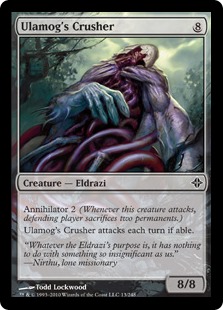
Let’s start with the Eldrazi, shall we? Did you know that the tagline of ROE is, “and carnage shall follow”? Most of the carnage is caused by the Eldrazi and their Annihilator triggers. Take a look at Ulamog’s Crusher: The Crusher’s “Annihilator 2” ability forces the defending player to sacrifice two permanents whenever it attacks. You can find the official rules on Annihilator here.
Eldrazi Drones and Spawn
Eldrazi Spawn are colorless 0/1 creatures with a single mana ability: “Sacrifice this creature: Add 1 to your mana pool”. Eldrazi Spawn are created by black, red, and green spells and creatures, as well as by some colorless spells. They help to power out expensive Eldrazi and fuel large, game-ending spells. Against aggressive decks, the Eldrazi Spawn provide blocking fodder to buy time. Note that, just like the Eldrazi themselves, Eldrazi Spawn are colorless non-artifacts, which means that they won’t be able to block creatures with the intimidate ability.
You can read more about Eldrazi and their minions in Part II. However, there are many more ways to spend your mana in ROE limited:
Leveler Cards
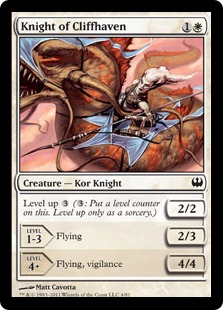
Knight of Cliffhaven is a great example of a Leveler card. It starts out as a Glory Seeker. For the (sorcery-speed) investment of 3 mana, it gains a level counter and turns into a respectable Sunspire Griffin. Later on in the game, the fourth level counter transforms the Knight into the iconic Serra Angel, one of Magic‘s most iconic game-winners ever.
For the most part, a Leveler card behaves as one would intuitively expect. If you ever need more details, check out the official Leveler rules.
Leveler cards can be found in all colors, but are common only in white, blue, and black. Leveler decks are the focus of Part III of this primer.
Rebound

Rebound is a premier card advantage mechanic. In short, a spell with Rebound (official rules) comes back for a second resolution at the beginning of your next upkeep. Note that this is only the case if the original spell resolved with a legal target.
There are only 14 Rebound spells in ROE. Despite their low numbers, their impact on ROE limited is significant. The majority of Rebound spells naturally lend themselves to grindy, spell-heavy control decks. Those are discussed in Part IV of this primer.
Totem Armor
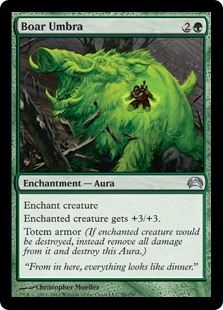
Auras with Totem Armor can be found in white, blue, and green. Totem Armor does not appear to be a complicated mechanic at first glance. However, many of the interactions with Totem Armor are somewhat counterintuitive. There were and always will be players of ROE who are confused and/or surprised about those interactions. Please don’t be one of those players.
The official rules are surprisingly short. In fact, Totem Armor acts very similarly to a regeneration shield. Both effects remove all damage and prevent destruction of the creature. Regeneration then taps the creature and removes it from combat. Totem Armor only results in the destruction of the Aura. In particular, the creature is not tapped and not removed from combat.
Here are a few noteworthy interactions that might come up:
- If a creature enchanted with multiple Totem Armors would be destroyed, its controller chooses which of the auras to destroy.
- If a creature with a Totem Armor also has a regeneration shield, its controller chooses which effect to apply, the sensible choice being regeneration in most cases.
- If you Vendetta a creature with a Totem Armor, you lose life equal to its toughness after the aura has been destroyed.
- A nonlethal Induce Despair on a creature with Totem Armor can make it very easy to get rid of both the creature and aura in combat. Dealing lethal damage causes the aura to be destroyed and the creature with 0 or less toughness to be put into the graveyard.
Auras, and Totem Armors in particular, can find their way into any deck. However, they also heavily support some of the fringe strategies discussed in Part V.
Defender
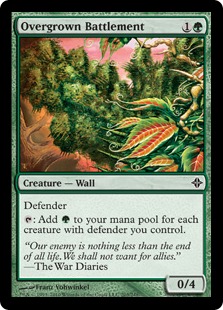
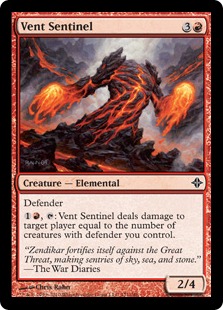
Just like the Return to Ravnica Block, ROE has a Defender subtheme. While Overgrown Battlement is one of the key cards in Eldrazi ramp strategies, going all-in on Defenders is also a viable strategy from time to time. The Wall deck is discussed in Part V together with other fringe strategies.
The Invoker Cycle
While not a mechanic per se, the Invoker cycle is too important for a primer on ROE limited not to mention. Inspired by the Invoker cycle printed in Legions, these creatures provide each color interesting and powerful ways to utilize extra mana. While fragile, Dawnglare Invoker is the best white common, and among the best non-removal first-picks in ROE. Not only is it an efficient flyer, but it all but guarantees a quick win on most boards as soon as its controller reaches 8 mana.
Strategic Conclusions
Thanks to the Eldrazi, an army of Level Up creatures, and the Invoker cycle, ROE is one of the most mana-hungry limited formats of all time. As is the case with most expert-level sets, this challenges traditional views on Magic‘s fundamental strategic concepts. Just looking at the above mechanics and cards allows us to formulate some questions and answers to keep in mind when drafting and playing ROE limited.
With the exception of Rebound, ROE is not a format defined by card advantage. Even a great card like Staggershock, the definition of a two-for-one, looks quite weak if your opponent just cast Ulamog’s Crusher or has already fully leveled up Knight of Cliffhaven. If ROE limited was a course in Magic strategy, the course’s topic would be abundant mana and what to do with it.
Magic is a game in which mana is the resource that pays for cards of varying utility. ROE is a limited format in which the average card utility ceiling is incredibly high. The utility provided by these cards comes with a price tag, as evinced by cards and abilities with high mana costs (Eldrazi, Invokers) and huge mana sinks in the form of Level Up creatures. As a result, drawing your 8th mana source is much better than in traditional formats. This is underlined by the fact that the nonland mana sources (Eldrazi Spawn, Overgrown Battlement) of ROE provide additional utility in combat and in interaction with many cards like Broodwarden.
There are three main strategies in ROE limited: Ramp, Aggro, and Control. Ramp decks use the mana they produce to power out Eldrazi and other fatties very early in the game. The most common Aggro decks are usually Leveler-based. This often means that the 2- and 3-drops you face early on in the game threaten becoming game-ending threats. Aggressive decks with a few expensive bombs are among the most powerful decks in limited, and Level Up decks are the epitome of that. Last but not least, Control decks in this format try to collect as many answers as possible, and the nature of ROE forces them to respect creatures of almost any power and size from any deck. If drafted correctly, Control decks are capable of outlasting even a deck full of Levelers or Eldrazi through card advantage and unconditional removal, often supported by one or more semi-expensive rare creatures like Drana, Kalastria Bloodchief or Sphinx of Magosi to dominate and close out games.
All of the above decks make great use of late-game mana. Mana producer counts of 18 are common, with Ramp decks easily supporting more.
Click here to go back to the top.


I would challenge you to hardcast Emrakul, the Aeons Torn in this format. However, barring multiple Overgrown Battlements, 15 mana is simply too ambitious for even the most rampy decks. When it comes to mythics, All is Dust and Kozilek, Butcher of Truth are very reasonable inclusions, and you’ll know when you can support Ulamog, the Infinite Gyre. In general, stay away from cards that cost more than 10.
When it comes to the colorless rares, Eldrazi Conscription is one, if not the, best first-pick in the format. While there might be cards that are even stronger (Drana, Kalastria Bloodchief comes to mind), its lack of color gives it the edge. Note that both Angelheart Vial and Keening Stone have their applications despite looking like cards that would be too expensive and/or slow in other formats.
The best cards to support the high casting cost of Eldrazi are those that provide more than 1 mana. Dreamstone Hedron is quite expensive to get out, but one of the best ramp cards once it is active. Just as before, reaching 11 mana for Pathrazer of Ulamog is too ambitious in almost all scenarios, but Artisan of Kozilek provides great value in all matchups for only 9 mana. Best served (cast) after the opponent has suffered great losses dealing with last turn’s Ulamog’s Crusher.
The Crusher is the only common Eldrazi you truly want. While Hand of Emrakul can come down as early as Turn 3 with its alternate casing cost and win the game on the spot, it is a lot worse than the Crusher and the other 9-10 mana Eldrazi. You don’t want to go all-in on a mediocre Eldrazi just to be punished by one of the many removal spells or a timely Regress.
Most green rares are pretty self-explanatory, providing mana supply (Awakening Zone) or late mana sinks (Gelatinous Genesis), respectively. Kazandu Tuskcaller is an exception to the rule and warrants an early pick in draft, as it threatens to take over the game as early as Turn 4. One of the best green rares when it comes to power is an innocuous 1/1, Gigantomancer. It doesn’t take a lot to win once all your creatures are 7/7.
Joraga Treespeaker (aka Sol Ring) and Pelakka Wurm (the only green ‘Eldrazi’) are the premier uncommons for the Ramp archetype, covering the need for mana and high-impact cards, respectively. Bramblesnap and Jaddi Lifestrider provide early-game defense and additional use for Eldrazi Spawn tokens. However, don’t forget that the primary use for your Spawn tokens in the green Ramp deck is to cast huge Eldrazi.
Green’s commons don’t have a particularly high power level, but offer a lot of support for a Ramp strategy. Growth Spasm, Kozilek’s Predator and Ondu Giant are great at ramping (with the latter two providing the most utility), but Overgrown Battlement is not only the cheapest but also the most efficient of them all. Pick them early and go nuts.
Just as with constructed ramp decks, this archetype needs a healthy mix of mana acceleration and high-impact cards. Two cards that glue this deck together are Ancient Stirrings and Wildheart Invoker. The former acts as either a mana source or an expensive threat in time of need, while the latter is a super-efficient 4-drop with a mana sink ability that dominates most battlefields.
The Eldrazi ramp decks are usually green, and most commonly paired with red or black. Green provides the best ramping, followed by red with Defender-support for Overgrown Battlement and a solid amount of Eldrazi Spawn generation. Apart from supporting Defenders like Vent Sentinel, red offers Emrakul’s Hatcher as a non-permanent but significant mana boost. Spawning Breath can catch some Levelers before they level up while providing a single Eldrazi Spawn. An honorable mention goes out to Battle-Rattle Shaman, which, while not at the core of a ramp strategy, significantly improves your position on the battlefield almost independent of your overall strategy.
Black is a distant third when it comes to ramping, but offers the best removal suite. From time to time a black-red Eldrazi deck sees the light of day, but those are rare. White and blue are rarely combined with Eldrazi as the Leveler cards act as mana sinks and steer the deck in a more aggressive direction. Blue-green and white-green decks are a possibility, but often build around single-card strategies (Aura Gnarlid) and great stand-alone cards like the Totem Armors rather than Eldrazi.
Because of their scarcity and the fact that many players will pick them up early, the Eldrazi Ramp deck is not always full of Eldrazi themselves. In the best case, you can make use of your ramp cards and Eldrazi Spawn with similarly powerful lategame spells. If that fails, there are many fringe strategies that attempt to get value out of extra Spawn tokens and mana. In practice, the green decks of a given draft are hybrids between the archetypes discussed above.
For reference, here is the PT San Juan-winning Black-Green Ramp deck of PVDDR, featuring black’s Eldrazi replacement: Skeletal Wurm.
Black-Green Ramp by PVDDR
|
| ||||||||
The PT San Juan Top 4 deck of Andrea Giarola is more interested in early pressure backed up by an Eldrazi Spawn-powered late game, but loosely fits into the ramp archetype as well:
Green-Red Ramp by Andrea Giarola
|
| ||||||||
The Green-Red Ramp deck that Bram Snepvangers drafted at GP Lyon is lacking strategic cohesiveness, but its single-card quality combined with the skills of its pilot were sufficient for a Top 4 finish.
Green-Red Ramp by Bram Snepvangers
|
| ||||||||
And finally, the beautiful (and textbook archetypical) decklist of GP Lyon finalist Tobias Gräfensteiner. Tobias was one of the two players in the GP Lyon Top 8 which I tested with in Puerto Rico before PT San Juan.
Green-Red Ramp by Tobias Gräfensteiner
|
| ||||||||
Click here to go back to the top.
White’s rares and mythics contain some slam-down first-picks in the form of Gideon Jura and Deathless Angel. Student of Warfare and Transcendent Master threaten to take over the game on their own if given enough time. Two cards that warrant mention are Nomads’ Assembly and Hedron-Field Purists. The former can grow out of control very easily, while the latter is deceptively powerful. Winning against a mid-sized board that includes a fully leveled Purists is nigh impossible.
Most of white’s uncommons are solid to good, with efficient cards like Wall of Omens and Mammoth Umbra. There is even a great removal spell in Oust to delay Eldrazi or Leveler creatures in any training stage. However, the true gem for the Leveler deck is Time of Heroes. Note that it requires you to level up each of your creatures at least once, but then acts as a Crusade on steroids. On a related topic, Kabira Vindicator is well worth the investment if you can spare at least 6 or even 15 mana during the course of its existence on the battlefield. Affa Guard Hound is one of the two Flash creatures in ROE, and you are more likely to run into it than Haze Frog.
Dawnglare Invoker is the best white Common in ROE. There are two situational pieces of removal in Kor Line-Slinger and Puncturing Light, which help greatly early on against Levelers and other small creatures, but won’t stop any Eldrazi. Most Leveler decks should strive to be evasive to circumvent ground-based Defenders and Eldrazi Spawn from halting your offense. This is why a respectable card like Caravan Escort cannot remotely compete with Knight of Cliffhaven. The more evasive your deck is, the better Guard Duty becomes, which is an important piece in the puzzle of how to handle opposing Eldrazi. Last but not least, Smite is somewhat schizophrenic in one of the more aggressive colors of ROE, but at the same time less restrictive than most of white’s other removal.
The blue cards in ROE are not nearly as aggressive as their white counterparts. However, there are multiple cards that perfectly supplement the white Levelers, while others are more fitting in a blue-based control approach. A card that is great in both is Sphinx of Magosi, which is very difficult to beat if its controller gets to untap. The best rares for the Leveler deck are Coralhelm Commander and Training Grounds. While the Merfolk Soldier is clearly powerful, Training Grounds is a little more subtle in its effect. Best when cast on Turn 1, it significantly reduces the Level Up cost of all your creatures, which means that the board states created on Turns 4 or 5 are akin to those of Turn 10 in a regular game. Cards that produce a mana advantage of such magnitude for so little investment are hard to find. Closing out the blue rares is Gravitational Shift, which can put a good evasive deck over the top, but doesn’t work in just any deck.
While Enclave Cryptologist is quite defensive, it is the best blue uncommon. Even if your main plan is attacking, drawing more cards than your opponent has always been a viable strategy. If you can afford to reach Level 3 within the early turns, do so. For the Leveler deck, Drake Umbra provides a well-suited combination of evasion and protection, which is doubly important if a lot of mana has been invested in the enchanted creature. Albeit not a Totem Armor, Domestication is an even more powerful aura, and a very reasonable card for which to move into blue early on in a draft.
Blue’s premium common is Narcolepsy, followed by Skywatcher Adept and Frostwind Invoker. In the best case, you can pick those early while cards like Venerated Teacher and Champion’s Drake go around the table much later. Halimar Wavewatch is significantly weaker than the Adept, but was the bane of many blue mages in 2010. It is best used as a cheap 0/6 or an evasive sideboard card. Remember that your opponent could cast Fleeting Distraction or Eel Umbra if he or she is making questionable attacks.
Just like in ramp, black is a distant third in the Leveler archetype as well. However, you can never count out a color with efficient removal and powerful rares. The most powerful of all is the nigh-unbeatable Drana, Kalastria Bloodchief. Depending on the matchup and the stage of the game, Guul Draz Assassin is almost as powerful. Other good black Leveler cards are Nirkana Cutthroat due to its early effectiveness and Zulaport Enforcer due to its lategame evasion. Desceptively powerful is Cadaver Imp, which is a small evasive threat itself and recoups early losses. Thanks to Level Up, those early losses might come back with a vengeance.
When it comes to removal, Corpsehatch is a good answer to most threats in the format. However, Vendetta is the better option most of the time, in particular for an aggressive Leveler deck. Vendetta is competing with Staggershock for the title of best common, and I firmly prefer the black instant. Be careful of Induce Despair, however, as the additional cost of revealing a high-casting cost creature does not work well with Levelers. Last Kiss and Bala Ged Scorpion round up the removal suite, but suffer from being limited to affecting small creatures, which are most likely not the problem creatures to a Leveler deck.
Looking at the cards, it becomes clear that black is not the preferred option for a Leveler deck. The white Levelers are the most powerful, and blue offers great synergy and support cards. However, keep in mind that combo cards like Champion’s Drake and Venerated Teacher can backfire as they allow your opponent to focus their answers on a smaller subset of creatures.
Noah Swartz made Top 4 for PT San Juan with powerful Levelers and Time of Heroes:
White-Blue Levelers by Noah Swartz
|
| ||||||||
Guillaume Matignon’s decklist shows that Blue-Black Levelers is viable, and his 2nd-place finish is proof of the power of Training Grounds:
Blue-Black Levelers by Guillaume Matignon
|
| ||||||||
Peter Vieren finished in the Top 4 of GP Lyon with his take on white-blue Levelers, including a heavy aura component.
White-Blue Levelers by Peter Vieren
|
| ||||||||
Click here to go back to the top.
Control decks are the third pillar of ROE Limited. Removal, card advantage and lategame power plays are a necessity to compete with the other decks in the format. The best control decks can stop the Leveler decks early and the Ramp decks later on. However, the many fringe archetypes and different takes on known strategies can make it difficult to present the right answers at the right time. Control decks are not only viable, but among the most powerful decks in the format and reward experience with the format more than any other strategy.
Conquering Manticore is a great red card in any red deck, and works particularly well against Eldrazi. Cards of similar power level are Lord of Shatterskull Pass and Magmaw. Cards that a control deck happily plays include Tuktuk the Explorer and Disaster Radius. My favorite card to abuse is Splinter Twin, which provides great value with lots of creatures, and creates soft locks with Mnemonic Wall and some of the better spells in the format. Two blue cards that shine in control decks are Echo Mage and Recurring Insight. In black, Consuming Vapors and Consume the Meek not only provide additional removal, but also tempo swings and Leveler hate. The more expensive black cards like Nirkana Revenant and Pestilence Demon are also well-suited towards control, if they don’t end up in ramp strategies instead.
This archetype is the one which most commonly ends up in a true three-color deck. As such, it makes better use of Evolving Wilds and Prophetic Prism than other decks. The common triforce that defines this deck is Vendetta, Narcolepsy, and Staggershock. Flame Slash and Heat Ray round out the red removal spells. The card advantage provided by Cadaver Imp, Sea Gate Oracle, Bala Ged Scorpion, and Mnemonic Wall ensures that the control deck does not run out of cards before the opponent does.
Some of the more subtly effective cards include Deprive as a catch-all answer, Shrivel as a nightmare to Eldrazi Spawn decks, and Regress to punish Spawn-powered Eldrazi, leveled Levelers and Totem Armor strategies alike, or to protect and reuse your own enters-the-battlefield creatures.
There are a few uncommons worth mentioning. A leveled Brimstone Mage dominates some decks on his own. Guard Gomazoa and Escaped Null provide different, but vital defensive support. However, the king of control uncommons is undisputed:

In the GP Lyon Top 8, my friend Florian Koch is the second person that took part in our testing for the PT. He won the Grand Prix with two copies of Surreal Memoir in one of the best limited decks I have ever seen:
Black-Red Control by Florian Koch
|
| ||||||||
As far as I can remember, Surreal Memoir is Florian’s most drafted ROE card on Magic Online – quite a feat given that it is an uncommon. It is impossible to improve on perfection, but Joakim Amelund drafted a blue-black control deck in the same Top 8:
Blue-Black Control by Joakim Amelund
|
| ||||||||
The white-blue-black deck of Kotarou Ootsuka at PT San Juan is a control deck in Leveler colors, but well worth a look. Note that Ootsuka’s most powerful spells are supported by two Totem-Guide Hartebeests and an aura toolbox.
WUB Control by Kotarou Ootsuka
|
| ||||||||
Click here to go back to the top.
One of the best things about ROE limited is the sheer number of playable fringe archetypes. Due to the randomization of cards in booster drafts, established and fringe archetypes merge together to create interesting hybrids. In ROE, anything can happen. Listing every possible fringe archetype is impossible, but here is a short list to get your creative juices flowing:
- Kiln Fiend works great with Rebound spells and Goblin Tunneler. Distortion Strike deals insane amounts of damage with Kiln Fiend, and sometimes you can be lucky enough to go off with Surrakar Spellblade or Sphinx-Bone Wand. (Verdict: Sign me up!)
- Brood Birthing powers more reckless Eldrazi decks that might even want Hand of Emrakul. (Verdict: Not for me.)
- What to do with all those Spawn? Raid Bombardment creates winning board states out of nearly nothing. Add cards like Lavafume Invoker and Might of the Masses or black for fringe cards like Bloodthrone Vampire and Mortician Beetle. (Verdict: Don’t overdo it.)
- You can’t talk single-card strategies without mentioning Aura Gnarlid. Apply Totem Armor, proceed with winning. One of the better uses of combining blue and green in ROE. (Verdict: Once a fan, always a fan.)
- Go balls to the Wall. If winning with Vent Sentinel is too easy, equip Warmonger’s Chariot to Rage Nimbus and go to town. (Verdict: Go for it.)
- Explosive Revelation into Emrakul, the Aeons Torn. (Verdict: You only live once!)
As you all know, the Pro Tour is serious business, which is why everyone in the Top 8 of PT San Juan had a serious deck. Well, except for Brad Nelson, who went deep. Thank you, Brad.
Green-Red Raid Bombardment by Brad Nelson
|
| ||||||||
Click here to go back to the top.
Part VI: Practical Tips and Conclusion
When drafting out-of-print formats on Magic Online, you usually have the option to join a draft queue with tickets and boosters of the corresponding set(s). If you don’t have enough of those packs, you can enter with tickets only. However, if you add up the secondary market prices of booster packs, you usually come up lower than paying the ticket-only entry fee.
If you are interested in drafting as economically as possible, you should know beforehand which cards in the set are in high demand. For that purpose, before joining a draft, check out this list of all the Magic Online cards from ROE that are worth more than $1 or 1 event ticket.
For the draft itself, I suggest starting off with one of the most powerful cards in the pack. Prioritize bombs, unconditional removal, and cards that are good in both the early and late games. The cards you started with might give you an idea in which strategic direction to take your draft. It is, however, often a mistake to commit to a strategy too early. In a format as powerful as ROE, you don’t want to end up in a deck which didn’t come together because you ignored the signals from your right after one or two early pickups.
If you want to learn more about the mechanics and strategic concepts of ROE, check out some of the links below, watch these videos of me drafting the set with this primer in mind, or research the format for yourself. Just remember that in the end, nothing beats drafting, playing, and learning of your own. Don’t be fooled by the intricacies of Totem Armor. Play enough lands. Don’t let an early Staggershock wreck your day. Annihilate your opponents. And carnage shall follow.
Simon Görtzen
@simongoertzen
Assorted Links to External Resources
Simon Says episode in which I draft Rise of the Eldrazi
Gatherer:
Full Set
List of Instants
List of Flash spells
PT San Juan Event Coverage
PT San Juan Top 8 Decklists
GP Lyon Event Coverage
GP Lyon Top 8 Decklists
PT San Juan Report by PVDDR:
Part 1
Part 2
Part 3
ROE Set Review by LSV:
White
Blue
Black
Red
Green
Colorless and Sarkhan

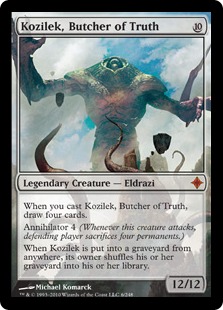
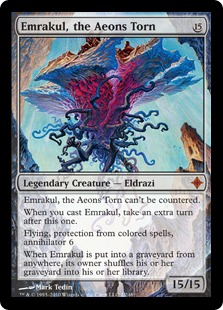
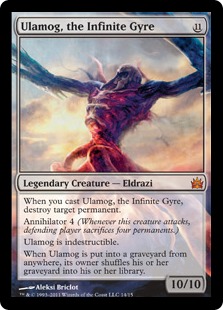
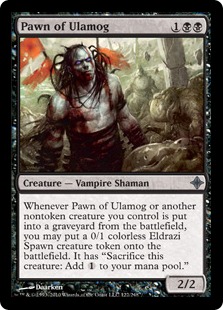
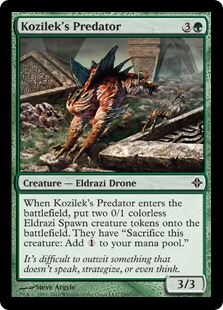
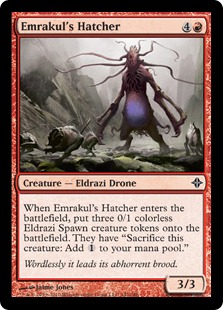
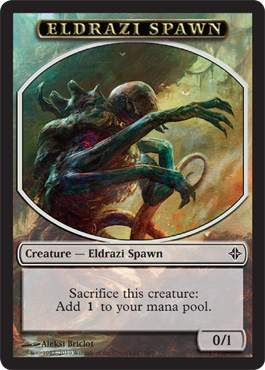
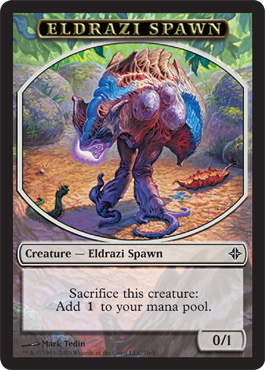
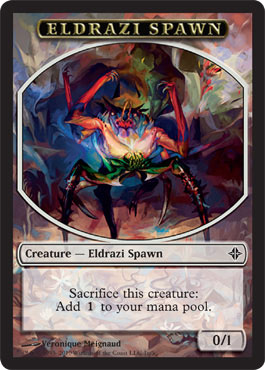
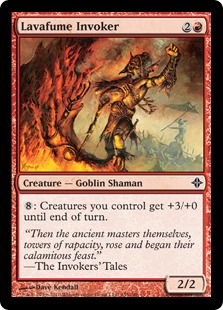
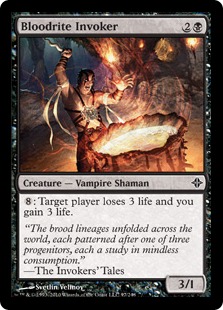
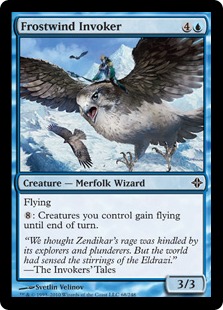
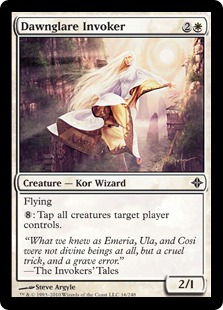
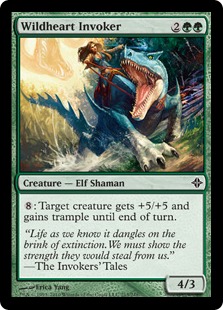

This was awesome.
For those of you wondering, the information on ROE drafting for the next week on Magic Online can be found here:
http://www.wizards.com/Magic/Magazine/Article.aspx?x=mtg/daily/other/07092013c
One of the better draft sets. And you did a good job reviewing ROE.
Sometimes Pro’s think too much, they try always to play around card xyz. But it is no shame to lose against PV, because you gave him too much credit
Pro’s are still humans, they all make mistakes. I don’t know but after playing 8 rounds of Magic, are you still 100% concentrated?
Is there a Magic game whitout any play errors?
Awesome content, Simon, as usual! Having one article that describes the format very well and links to all important sources is greatly appricated. It is time for Rise of the Eldrazi, folks!
Dobře řečeno, Plejades
My favourite author does a in-depth on one of my favorite draft formats. Win!
Didn’t really mention Kor Spiritdancer. I wasn’t playing when ROE came out, but from the draft videos I’ve seen, it + totem armor seems good. Obviously you shouldn’t build around this as your only strategy, but is it worth at least trying to play white if you open it first pack?
Also, if anyone can suggest first pick ratings. This is always something I have trouble with drafting an unfamiliar format. Like, if you see a great rare ramp spell first pack, and an ulamog, should you go for the ramp and then hope for a later ulamog, or another pack, etc? I’m a lot better at sealed than draft for this reason, draft definitely takes a fine tuned understanding of card value that I’ve never been great at.
As someone who stopped playing Magic for a big stretch of time and only in the past year gotten back into it, I love when older formats show up to draft on Magic Online and I love playing them and getting to experience sets that I missed out on. However, it can be a huge disadvantage when playing them to have no experiences with the format. That’s why I’m so glad to see this kind of article. It certainly won’t make up for not having played the format, but it does a ton to bridge that gap and give players like me a decent chance to do well in these drafts.
Thanks so much for this and I’m really looking forward to seeing more of these down the road with other older sets that get brought back to draft.
It was a very pleasant surprise to see “out of schedule” content from you. The timing is perfect and the info you compiled is a great refresher for the format. Are you going to make similar articles for other old formats?
The only suggestion I would like to make is that maybe you can draft RoE for your next regular submission and then combine it with this article (tutorial?).
Thanks for making this!
@TexRob the LSV-Ratings are good for starters. I tend to draft something like this:
First Bombs, then Removal, then solid stuff that keep me open (I don’t like to commit too much with my First Pick). I also tend to take rare over uncommen/common or uncommen over commen.
I think i would go with Ulamog over ramp, but that all depends on the rest of the booster.
I hope you’re going to be doing videos of the format!
Wow, never read one of your articles before but they are awesome! Thank you!
Incredible article, probably the best and most detailed draft primer I’ve ever had the pleasure of reading. Very helpful. Thank you.
This is my first time reading an article on this site, and now I’ll check back for more. Extremely good draft article, REALLY looking forward to the rest in the series! I hope you’ll be able to cover every block eventually!
Glad you folks liked Simon’s work. We’ll be hosting additional primers for other blocks, written by other experienced players.
Prety good, but I stop reading could have been make better pro, IMO of course. Basical it is because Theros’ limited is a better draft format and of course Thermos is more relevent.
But good article’s anyway, I like good writen strategy’s.
This is another 10 or 11 part series on ROE that is awsome http://puremtgo.com/articles/forks-and-cornerstones-introduction-rise-eldrazi-draft-part-i
Too bad this didn’t get up until day 3 of ROE-drafting… allready did 4 drafts, they might have gone a lot better if i read this in advance !
But it was great to read, allthough i allready know all the cards good, it still is a plus to get it all together again for a nice overview.
This is so awesome article.
Perfection in every sentence.
knx – This article has been around for a few months – it was just returned to the main page because of the format’s brief return, I think.
Correct, Maestro.
Major thankies for the article. Much obliged.